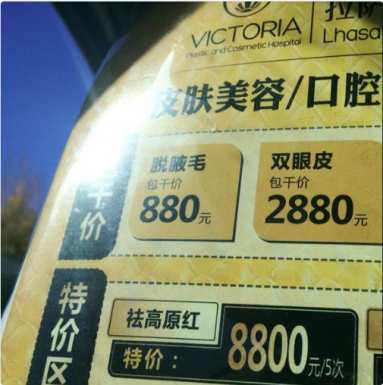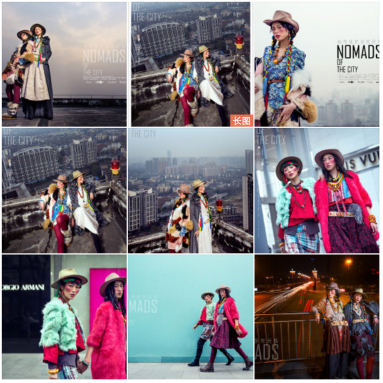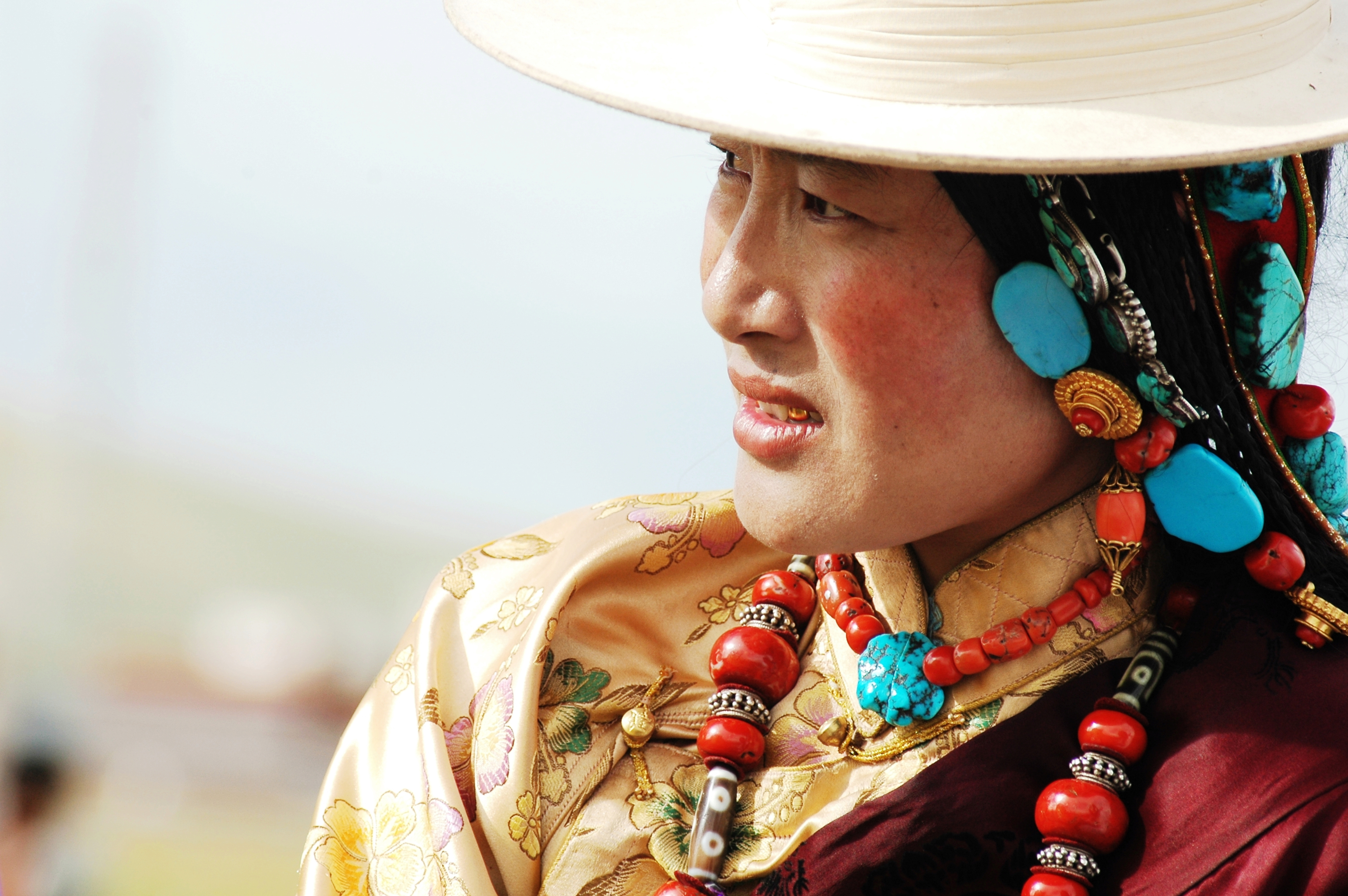"Plateau redness" of Tibetan faces is so notable that it's inspired songs—so what is the significance of its potential disappearance?
Image © Bbbar | Dreamstime.com
“I remember when I was young, during my first trip to Chengdu, standing amid the hustle and bustle of crowds on Chunxi Road, where, no matter what clothes you were wearing or whether you opened your mouth to speak, from the wisps of natural rouge upon one’s face everyone could immediately identify a Tibetan girl.” So goes this piece, initially published on WeChat (a messaging platform popular in Tibet) by a young Tibetan student, which introduced me to “plateau redness,” the characteristic bright red cheeks of Tibetan people. It’s a feature I’d not known that I’d noticed, but when I stopped to think of iconic images of Tibetans, red cheeks were indeed an unmistakable feature.
That might not be the case much longer. The conditions that prompt plateau redness haven’t changed, of course; the cold, windy, elevated plateau continues to dilate the blood vessels of Tibetan faces. But Tibetan women are subject to the same beauty ideals of women in China, where pale, unmarked skin has become the standard-bearer of beauty. Products that promise to erase or camouflage plateau redness line the shelves of cosmetics stores in Lhasa. People are also more likely to protect their skin from the sun now (sun damage in and of itself doesn’t cause the redness, but it exaggerates its effect). Add in the unique political concerns of Tibet and the ways state-run Chinese media examines the issue, and plateau redness becomes a case study of how beauty, identity, policy, and culture are inextricably entwined.
I urge you to read the original essay here; the writer cannot be identified for safety reasons. Tricia Kehoe, an Irish scholar of Tibet, translated the essay—and penned a follow-up, which is adapted below. You can read Kehoe’s original post here, and you can follow her on Twitter here. Many thanks to reader Willa who pointed me toward this essay coupling in the first place.
Reading through a few articles from Xinhua, China News, and other major news outlets, I noticed that state media have been quite consistent in their discussions of plateau redness. Like most reportage on Tibet in state media, the plateau redness coverage was framed by discourses of science, progress, development, and increasing integration with interior China and the world, often juxtaposing “old Tibet” and “new Tibet.”
In 2013 a piece from state mouthpiece Xinhua entitled “Tibet’s ‘Plateau Redness’ is Becoming Rarer” explained that the disappearance of plateau redness is simply a case of Tibetans coming to “understand more of scientific culture (kexue wenhua)” and “how better to protect themselves.” In a bizarre attempt to put a positive spin on climate change, the same piece, quoting a professor of medicine at Tibet University, also made the argument that:
Global warming is leading to an increase in Tibet’s vegetation, more rainfall, more moisture, and an increase in the amount of oxygen in the air. These changes are making peoples’ skin better able to retain moisture, thus lessening the occurrence of dry, cracked skin, and plateau redness.
More typically, state media tends to dismiss plateau redness as an illness of bygone times before health awareness took hold. Citing Nyima Tsering, director of the Tibetan Medicine Institute in the Tibet Autonomous Region, a China News article in 2015 entitled “The Plateau Redness that is now Disappearing” stated “actually plateau redness is really not as beautiful as imagined, it is a type of plateau illness.” Similarly, in 2013 Xinhua ran a piece entitled “Tibetans Hope to Get Rid of Red Cheeks” that discussed Tibetan women’s increasing sense of “irritation” with plateau redness and Lhasa’s bustling cosmetics market. Degyi, a cosmetics saleswoman in Lhasa, was quoted as saying “we used to bask in the sun for warmth and had no knowledge of the harm the exposure could do. Today, we have a better understanding of how to protect ourselves.”
A quick search on Chinese search engine Baidu turns up no end of articles and forum threads discussing how to get rid of plateau redness. The advertisement below for Victoria Plastic and Cosmetic Hospital in Lhasa offers a “plateau redness removal” service for 8,800 RMB.

Keeping the above in mind, let’s get back to the essay that’s prompting discussion here. The piece, titled “Tibetan Girls, We Are in the Process of Losing Tibetan Redness” exhorted Tibetan women to reconsider their redness as a symbol of national pride:
The plateau bestows upon us a superior physicality, stronger lungs and heart, and a bright red face. These natural gifts leave us with nothing to feel embarrassed about. Within this information explosion that characterizes our present, so much is demanded, particularly of women. From being a perfect 50kg to the endless whitening brainwashing, we feel completely as though we ourselves are imperfect and are in need to change. In fact, there really is no need to live by the expectations of others.
Keeping a natural heart, and a natural appearance is also a manifestation of beauty.
On the Wechat platform where it was originally posted, it quickly generated discussion, garnered thousands of views, and was shared around the Tibetan blogosphere. The piece resonated with many women: Several posted comments expressing their agreement and praise. One comment praised the piece for allowing Tibetan women to “accept and even like our plateau redness. You wrote so well!” Another read “many people ask me why there is no plateau redness upon my face. I can only remain silent.”
Others, however, were critical of what they saw as an implicit suggestion in the piece that those without plateau redness were somehow less Tibetan. As one commenter remarked, “So only if you have plateau redness do you count as Tibetan?” Others joined in, arguing that this attempt to make plateau redness a compulsory feature of Tibetan women simply constituted another “a form of social violence.” Some were also irked by the burdens and limitations the piece placed on Tibetan women’s personal freedoms. One commenter wrote, “whether people decide to wear makeup or whiten their skin is really a matter of personal choice and determination, and we should not talk about it on the level of ethnicity.” Similarly, another commenter responded:
I am a Tibetan who was born and brought up in Tibet, but since I was a kid I have never had any kind of plateau redness. If outsiders think that people who live on the plateau must have plateau redness, that just tells you that they’re too narrow-minded.
While the essay certainly stirred up debate around questions of identity and authenticity, others were much more concerned about thinking about the reasons behind the disappearance of plateau redness.
Upon the plateau redness that exists on our face, we smear stuff, taking Han whiteness as beauty. We hardly realize that doing things like this, in this society of counterfeits, will harm our very own original skin and original form, and this is what is making plateau redness disappear…
Perhaps the most divisive point of the discussion was the degree to which Tibetans felt the loss of plateau redness was of their own making. Many argued that the disappearance of plateau redness goes far beyond being simply a matter of beauty trends and tastes. As one commenter wrote, “one of the main reasons plateau redness is disappearing has to do with the natural environment, rather than personal choice”; others wrote that “plateau redness follows the trends of changes in the environment and climate, and disappears” and that “I think Lhasa’s weather is less and less that of before, climate change should really be an influence in this.”
Others identifed an interrelated third factor, namely China’s inland schooling programs for Tibetans (xizang ban). Since 1985, as part of its “intellectual aid scheme” (zhili yuanzang), the Chinese government has been sending large numbers of Tibetan primary school graduates to inland secondary schools outside Tibetan regions. The cultural impact of inland schooling continues to be a very contentious subject of discussion among Tibetan netizens, and was also reflected in the comments on the loss of plateau redness.
Nowadays from a very young age many young Tibetans study in interior China and then their plateau redness slowly disappears. Also, before our diet was mainly tsampa but these days it’s basically rice and so on. These are just external changes, but the saddest part is that many have already begun forgetting their language and faith.
Because “plateau redness” will follow climatic and environmental change and transformation, and disappear. Following the upsurge in inland schooling classes so many students from the plateau study in interior China from a very young age. Once they go, that’s four years. They initially take their plateau redness with them to interior China and when they return to the plateau it has disappeared, and their skin has become white.
While the majority acknowledged the role that climate change, education, mainstream beauty standards, etc. play in the loss of plateau redness, not everyone viewed this as necessarily a negative development. As one commenter argued, the development of new beauty standards constitutes a sign of Tibetan development, openness, and greater integration in the world:
Pursuing what is fashionable does not mean not having a deep love for one’s own ethnicity. We are in the process of integrating into modern society, and this demonstrates our openness but we cannot lose our essential things. We study English, Mandarin, wear modern clothes, but this does not represent a lack of ethnic identification. This is the process of Tibetans moving towards the world.
Yet, there were plenty of others who took a far less rosy view of the situation:
The times are changing. Some things, we really haven’t intended to change but they change anyway. Just like some traditions that have already disappeared without a trace. If you want someone or something to blame, blame this nasty era.
To others, no matter the status of plateau redness, whether in the process of disappearing or not, “the blood that flows in our veins will never change.” Or, as another poster asked, “as long as there is a grain of love for Tibetans in your heart what does outwards appearance matter?”
Meanwhile, while Tibetans debated over the many fraught issues of identity, climate change, and inland schooling, plateau redness was being mobilized elsewhere in a fashion shoot the photographer dubbed “Nomads in the City.” The photography collection featured two Han Chinese female models ostensibly posing as Tibetan nomads on a stroll around the high streets of one of China’s sprawling urban centers (looks like Chengdu to me). I found the following spiel on the photographer’s Weibo page about what the photo collection is supposed to represent:
From today’s perspectives, the nomadic lifestyle is pretty bohemian. They are of no fixed abode, they take their tent this way and that, settling wherever there is water and grass. They have no home. Wherever they pitch their tent is home, not unlike gypsies. This life of unrestrained freedom remains the fantasy of so many modern urbanites who perhaps walk and walk, not knowing where they will pick up a girl of their liking.
 For full images, please visit the photographer's Weibo page.
For full images, please visit the photographer's Weibo page.
A bizarre pantomime mimicry of Tibetan attire and clownish attempt at plateau redness, the photos were eventually picked up by Taobao, a Chinese shopping site, and used to promote “Gegu Heavenly,” a new online store inspired by “ethnic culture” and specializing in necklaces, bracelets, earrings, antiques, and other ornaments. Gegu Heavenly has certainly been working hard to market their products by leveraging the many tired stereotypes of Tibetan nomads as wild, mysterious, exotic, romantic, and unrestrained bodies. Mobilizing an amplified plateau redness must have been considered as lending their brand an heightened charm of je n’ai sais quoi. Tibetans, however, were left cold; the few comments I read had little more to say than that the representations of urban nomads were a “complete sham” and “terribly ugly.”
Not that it’s only Chinese media that romanticizes plateau redness. As the woman who wrote the original essay points out, tourists come to Tibet expecting to see this mark of “true” Tibetan life, and are disappointed by what they don’t find: “[T]hey see the great Potala Palace that they have longed to see and snap shots of devout pilgrims to Jokhang Temple they have longed to snap, but they rarely see the ‘plateau redness’ of Tibetan girls. They suddenly see the difference between the Tibet they have learned about from propaganda and that of reality.”
Like so much of the socio-cultural landscape in contemporary Tibet, the politics of plateau redness are deeply embedded in wider ongoing debates concerning identity, cultural assimilation, migration, education, climate change, and so on. “Tibetan Girls, We are in the Process Losing Tibetan Redness” and the many comments it generated reflect so many of internal dilemmas and conflicts experienced by Tibetans living in the shadows of the dominant Han culture and state. Yet unlike so many debates and discussions of this kind, the politics of plateau redness was dominated by Tibetan women. Across state media and the essay comments I saw no references to Tibetan men’s relationship to plateau redness. Does plateau redness not concern Tibetan men? Where is the male gaze in all this? I briefly posed the question to the woman who penned the essay I translated. She responded that it was something she had not considered when writing the piece, but suspected the issue would resonate with many men.
In many colonial and postcolonial contexts, the struggle for cultural preservation, recognition, and respect is often a notably gendered phenomenon. Not merely the biological reproducers of the nation, women are also seen as cultural reproducers. Exploring the intersection of gender and nationalism, scholar Nira Yuval-Davis writes, “Women are often constructed as the cultural symbols of the collectivity, of its boundaries, as carriers of the collectivity’s ‘honour’ and its intergenerational reproducers of culture” (Gender and Nation, 1997). From India to Ireland, situating women's bodies at the center of the struggle against colonialization has been and continues to be a very common motif, and the plateau redness debates suggest a similar narrative at work among Tibetans. Caught between pressures to conform to Han and Tibetan beauty ideals, both Tibetan women and plateau redness stand on precarious ground.
